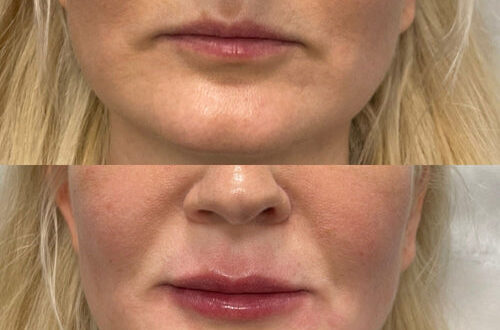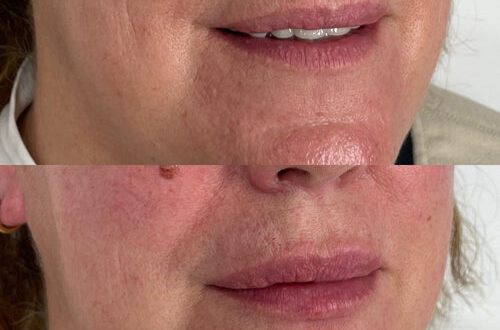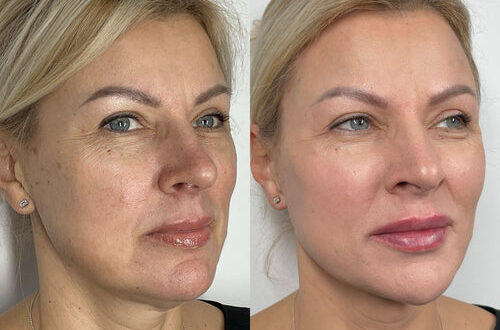Book Your Dermal Filler Appointment with Dr. Laura Geige at It’s Me and You Clinic
Immediate Actions
Cold Compresses
Immediate actions can help minimize swelling after lip filler injections.
First and foremost, avoid touching or rubbing the treated area as this can exacerbate inflammation.

Next, apply a cold compress for 15-20 minutes at a time, several times throughout the day.
This helps constrict blood vessels, reduce swelling, and numb the area.
A clean washcloth wrapped around ice packs or frozen vegetables work well for this purpose.
Be sure to use a barrier between the ice and your skin to prevent direct contact and potential frostbite.
It’s also crucial to stay hydrated by drinking plenty of water.
This helps flush out excess fluid and promotes healing.
* Applying cold compresses to the affected area for 1520 minutes at a time can help constrict blood vessels, reducing inflammation and swelling.
When undergoing dermal filler injections, some individuals may experience temporary swelling in and around the lips. This is a normal reaction to the injection process.
Here’s a breakdown of immediate actions you can take to minimize this swelling:
**Applying cold compresses** to the affected area for _15-20 minutes_ at a time can help constrict blood vessels, reducing inflammation and swelling.
It’s recommended to use a clean cloth or ice pack wrapped in a towel to prevent direct contact with the skin.
**Avoid touching or rubbing** the injected area excessively as this can irritate the tissue and exacerbate swelling.
Elevating your head** while sleeping can also help reduce fluid buildup and minimize puffiness.
Elevating Your Head
Immediate actions are crucial after receiving filler injections to minimize lip swelling and promote optimal healing.
One of the most important steps is to elevate your head while resting. This can be achieved by propping yourself up with pillows, ideally at a 45-degree angle.
Elevating your head helps reduce blood flow to the area, which can minimize swelling.
Think of it like this: when you lie flat, gravity pulls blood downward, potentially leading to more fluid buildup in the lips.
By elevating your head, you counteract this effect and help keep the swelling at bay.
This position also promotes drainage, allowing excess fluids to move away from the injected area.
Staying hydrated is equally important. Water helps flush out toxins and keeps tissues healthy, aiding in the healing process.
Avoid consuming alcohol or caffeinated beverages as these can dehydrate you and potentially exacerbate swelling.
Gentle Massage
Immediately after lip filler treatment, it’s crucial to follow specific actions to minimize swelling and promote healing.
Apply a Cold Compress: Use a cold compress or ice pack wrapped in a towel to gently press against your lips for 10-15 minutes at a time, several times a day. This helps constrict blood vessels and reduce inflammation.
Avoid Touching or Rubbing: Resist the urge to touch, rub, or pick at your lips. Excessive manipulation can introduce bacteria and irritate the treated area.
Elevate Your Head: Sleep with your head slightly elevated using an extra pillow. This helps reduce fluid buildup in the face.
Stay Hydrated: Drink plenty of water to stay hydrated, which aids in overall tissue healing and reduces swelling.
Gentle Massage:**
After the initial swelling subsides (usually within a few days), you can incorporate gentle massage into your aftercare routine. This helps to distribute the filler evenly, improve circulation, and minimize lumpiness.
Use Clean Hands: Always wash your hands thoroughly with soap and water before touching your lips.
Light Circular Motions: Gently use your fingertips to make small, circular motions on the treated area for a few minutes at a time. Avoid using excessive pressure.
Avoid Deep Pressure: Do not apply deep or forceful massage as this can push the filler into surrounding tissues and cause uneven results.
Continue with Gentle Massage for Several Days:
Maintain gentle massaging throughout the week following your lip filler treatment to promote optimal blending and minimize any lingering lumpiness.
Over-the-Counter Options
Arnica Gel or Cream
Over-the-counter (OTC) options can provide some relief for lip swelling after filler injections.
Arnica gel or cream is a popular choice for this purpose.
It’s an herb that has long been used in traditional medicine to reduce inflammation and bruising.
While scientific evidence supporting its effectiveness is limited, many people find it helpful.
How Arnica May Help
Arnica is thought to work by inhibiting certain chemicals in the body that contribute to inflammation.
Applying arnica gel or cream topically may help reduce swelling, redness, and discomfort around the injection site.
When to Use Arnica Gel
Apply arnica gel or cream as soon as possible after filler injections.
Continue applying it several times a day for the next few days.
Follow the instructions on the product label carefully.
Important Note: While arnica is generally considered safe, some people may experience skin irritation or allergic reactions.
Always perform a patch test before using a new product.
Consult with your injector if you have any concerns or questions about using arnica gel for lip swelling.
* Arnica is known for its antiinflammatory properties and may be helpful in reducing swelling after filler injections.
Over-the-counter (OTC) options can be a helpful first step in managing lip swelling after filler injections. While they won’t eliminate swelling entirely, these remedies can often minimize discomfort and promote faster healing.
Arnica is a popular OTC choice known for its anti-inflammatory properties. It’s believed to reduce swelling by inhibiting the release of histamine, a chemical involved in inflammatory responses. Arnica is available in various forms, including gels, creams, tablets, and capsules. Topical application is usually recommended for lip swelling, as it allows for direct delivery to the affected area.
Cold compresses are another effective OTC measure for reducing swelling. The cold temperature constricts blood vessels, which helps decrease fluid buildup in the tissues. Apply a cold compress to your lips for 10-15 minutes at a time, several times a day. You can use a bag of frozen vegetables wrapped in a towel, an ice pack, or even chilled spoons.
Oral antihistamines, such as diphenhydramine (Benadryl) or cetirizine (Zyrtec), may be helpful for mild lip swelling associated with allergic reactions. Antihistamines block histamine’s effects, reducing inflammation and itching. However, it’s crucial to consult your doctor before taking any new medications, even OTC ones.
Staying hydrated is also important for minimizing lip swelling. Drinking plenty of water helps flush out toxins and promotes overall healing.
Antihistamines
Book Your Dermal Filler Appointment with Dr. Laura Geige
Over-the-counter (OTC) options can be helpful for reducing lip swelling after filler injections.
Antihistamines are a common first-line treatment for mild to moderate swelling caused by allergic reactions or inflammation.
They work by blocking the effects of histamine, a chemical released in the body that causes itching, redness, and swelling.
Here are some popular antihistamines available OTC:
- Cetirizine (Zyrtec)
- Fexofenadine (Allegra)
- **Loratadine** (Claritin)
It’s important to follow the dosage instructions on the medication label carefully.
In addition to antihistamines, other OTC options that may help include:
- **Ice packs:** Applying an ice pack to the affected area for 15-20 minutes at a time can help reduce swelling and pain.
- **Arnica gel or cream:** Arnica is a natural herb that has anti-inflammatory properties. It may help to reduce bruising and swelling.
If your swelling is severe, persistent, or accompanied by other symptoms such as fever or difficulty breathing, seek medical attention immediately.
Pain Relievers
Over-the-counter (OTC) options can offer some relief for lip swelling after filler injections. They typically aim to reduce inflammation and discomfort.
Pain relievers like ibuprofen or naproxen are common choices. These nonsteroidal anti-inflammatory drugs (NSAIDs) work by blocking the production of prostaglandins, chemicals that contribute to pain and inflammation.
It’s important to follow the recommended dosage instructions on the label.
In addition to pain relievers, applying a cold compress can also help minimize swelling. Wrap a bag of frozen peas or ice in a towel and apply it to the affected area for 15-20 minutes at a time, several times a day.
Some people find that arnica cream or gel, which is believed to have anti-inflammatory properties, may provide additional relief. However, more research is needed to confirm its effectiveness.
Remember, if you experience severe swelling, pain, or other concerning symptoms after lip filler injections, seek medical attention promptly.
When to See a Doctor
Excessive Swelling
Excessive swelling after facial filler injections is a common side effect that usually resolves on its own within a few days to a week.
However, in some cases, the swelling may be more severe or prolonged, warranting a visit to your doctor.
Here are some signs that you should see a doctor if you experience excessive swelling after filler injections:
- Swelling persists for more than two weeks.
- The swelling is accompanied by redness, warmth, pain, or tenderness at the injection site.
- You develop signs of infection, such as fever, chills, or pus discharge from the injection site.
- The swelling spreads to other areas of your face or body.
- You experience difficulty breathing or swallowing.
- You have a pre-existing medical condition that could be exacerbated by filler injections, such as diabetes or autoimmune disease.
Seeking medical attention promptly can help prevent complications and ensure proper treatment.
Signs of Infection
It’s important to remember that everyone reacts differently to dermal fillers, and swelling is a common side effect.
Most lip swelling from filler subsides within a few days to a week, but there are instances where you should seek immediate medical attention.
**When to See a Doctor Immediately**
You should see a doctor right away if:
- You experience severe swelling that doesn’t improve after a week.
- The swelling is accompanied by pain, redness, warmth, or tenderness in the affected area.
- You have difficulty breathing or swallowing.
- There are signs of infection, such as pus formation, fever, or red streaks spreading from the injection site.
- You notice any unusual lumps or bumps around the injection area.
Reserve a Dermal Filler Consultation with Dr. Laura Geige Now
**Signs of Infection**
Here are some common signs of infection:
- ***Redness*** and *inflammation* around the injection site
- ***Pain*** or tenderness that increases over time.
- ***Warmth*** to the touch in the affected area.
- ***Pus*** formation, which may appear as a yellow or white discharge.
- ***Fever*** or chills.
It’s crucial to seek prompt medical attention if you notice any of these signs. Early diagnosis and treatment can help prevent the infection from worsening and causing complications.
Christina Stambolian Christina Stambolian Classy Pleasure Canniant Bronzed Body Spray Tan
- Alluzience Longer Lasting Botox Near Wimbledon, Surrey - April 16, 2025
- How To Reduce Lip Swelling After Filler - December 19, 2024



